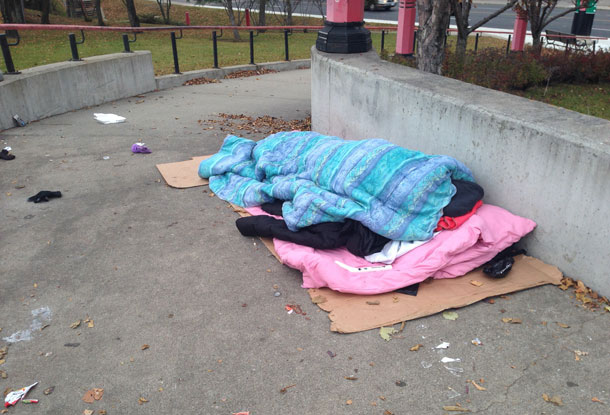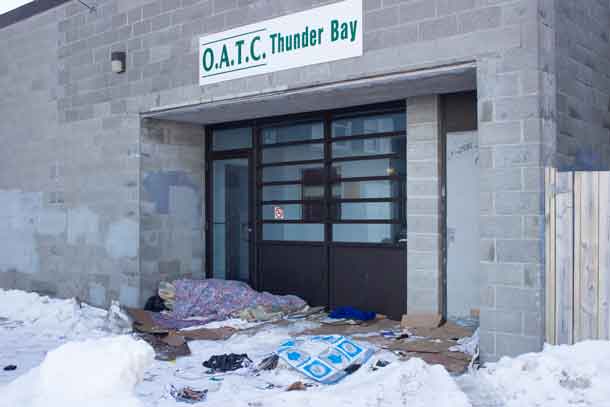

THUNDER BAY – Thunder Bay has a shortage of rental apartments. This issue has generated increased pressure on the housing market, and when combined with a growing youth population has led to a growing instance of youth homelessness. Not all of the homeless are able to be housed at the Rotary Shelter House. Some of the youth are couch surfing, living for a few days or weeks at the homes of friends or relative’s homes.
Other youth who are homeless are camping out in the city.
Ontario has the opportunity to be a leader in eliminating youth homelessness through a targeted strategy that would not only manage the crisis but prevent it, according to a new report released by the Canadian Observatory on Homelessness (Homeless Hub) at York University and A Way Home Canada.
At the moment, most of the effort and investment goes toward managing the problem through emergency services and supports, such as shelters and day programs. But the Canadian Observatory on Homelessness policy brief, Towards an Ontario Youth Homelessness Strategy, states there needs to be a shift towards prevention, reducing it by moving young people out of homelessness in a planned way and ending youth homelessness.
The long-term consequences of youth homelessness include an increased risk of exploitation, violence, physical and sexual abuse, more involvement with police and the justice system, stress, depression, anxiety disorders, suicide and drug use.

These are areas, in Thunder Bay where the Guardian Angels Canada and the Bear Patrol along with the SOS program are finding youth, chronic homeless people, and people with serious addiction issues. It is an area where there are frankly according to those who are on the streets trying to help and area that is treated like it is invisible in far too many cases. Often programs seem to be there to study the issue, and continue to study the issue leaving frontline action off of the program.
“A targeted provincial strategy to address youth homelessness would not only curtail the negative consequences, but create new opportunities to improve the lives of many young people,” said York U Professor Stephen Gaetz, director of the Canadian Observatory on Homelessness.
The proposed provincial strategy would help increase housing stability for youth through rehousing or family reunification and prevent homelessness through education, enhanced family supports, as well as access to education, income and employment opportunities.
While Ontario has made strides and commitments toward eliminating homelessness in general – it has committed to ending chronic homelessness in 10 years – the policy brief points to how it can make a real difference for youth. On any given night, there are some 6,500 homeless youth on the streets across the province. “More than a third of young people who experience homelessness in Canada are from Ontario,” said Gaetz. “Now is the time to act as there are more supports and higher recognition of the need for a youth homelessness strategy than ever before.”
A youth homelessness strategy should involve community planning, program interventions, including prevention, helping young people exit homelessness, training and support, as well as a mental health and addictions strategy. In addition, there should be targeted support for youth sub-populations, such as Indigenous and LGBTQ2S youth, which make up 25 to 40 per cent of the youth homeless population. These strategies should include the support of other levels of government and involve working with community partners and the mobilization of knowledge.
According to Melanie Redman, Executive Director of A Way Home Canada, “Communities across Ontario are either engaged in developing plans to prevent and end youth homelessness, or are poised to do so. The province has a real opportunity to support communities in these efforts, but the province does not have to do it alone. If we take a Collective Impact approach to youth homelessness we will go further faster in ensuring community plans lead to real change.”
For many, the path to adult homelessness began when they were young. Addressing youth homelessness now would impact the number of homeless adults in the future, but more supports and services designed to prevent youth homelessness are needed to make this happen.
York University is known for championing new ways of thinking that drive teaching and research excellence. Our 52,000 students receive the education they need to create big ideas that make an impact on the world. Meaningful and sometimes unexpected careers result from cross-discipline programming, innovative course design and diverse experiential learning opportunities. York students and graduates push limits, achieve goals and find solutions to the world’s most pressing social challenges, empowered by a strong community that opens minds. York U is an internationally recognized research university – our 11 faculties and 24 research centres have partnerships with 200+ leading universities worldwide.

